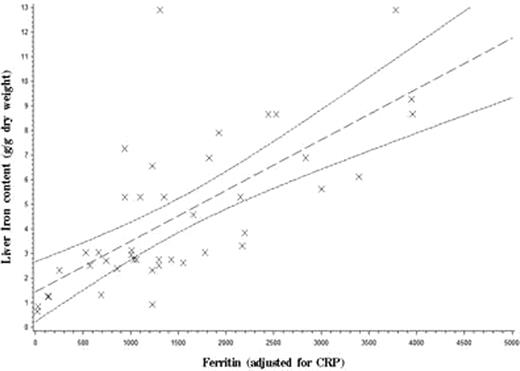Abstract
Abstract 3332
Poster Board III-220
Iron overload is a recently recognized problem for patients undergoing hematopoietic stem cell transplantation (HSCT). Hyperferritinemia is common and is associated with significantly increased treatment-related mortality (TRM) and poorer overall survival after HSCT. However, serum ferritin may be a poor surrogate for total body iron burden, and no prospective study of parenchymal iron overload has yet been reported. We initiated a prospective study of adult patients with acute leukemia or myelodysplastic syndrome (MDS) undergoing myeloablative HSCT, in order to estimate the prevalence of iron overload in this population. We measured pre-HSCT serum ferritin, C-reactive protein (CRP), iron, total iron binding capacity, and genotyped patients for HFE mutations. All patients also underwent liver and cardiac MRI with measurement of T2*, from which liver iron content (LIC) and cardiac iron loading were inferred.
41 of 45 planned patients have been enrolled to date. Median age was 46 years (range, 18-63). 24 patients had AML, 11 had ALL, and 6 had MDS. They had received a median of 2 prior chemotherapy courses (range, 0-6). Among the 39 patients with available transfusion history, the median number of prior RBC transfusions was 19 (range, 0-59). 88% of patients had a pre-HSCT serum ferritin above normal; the median value was 1432 (range, 20-6989). Higher ferritin values were associated with more advanced disease stage, number of prior chemotherapy regimens, and number of transfusions. The median LIC was 3 g/g dry weight (g/gdw) (range, 0.6-12.9). 85% of patients had an LIC above the upper limit of normal (1.8 g/gdw), and 17% had an LIC above 7 g/gdw. Only 1 patient had cardiac iron overload (cardiac T2*<20 msec). Pre-HSCT LIC correlated best with serum ferritin (r=0.7), although it also correlated with transfusion history (r=0.56) and with transferrin saturation (r=0.50). The correlation improved further (r=0.76) when ferritin was divided by log(CRP), when CRP was above normal (see Figure).
Median follow-up after HSCT is 4.5 months (range, 0.2-13.5), precluding full analysis of clinical outcomes at this point.
Hepatic iron overload is very common in patients with acute leukemia or MDS undergoing HSCT, and is strongly correlated with transfusion history. Cardiac iron overload is rare. Pre-HSCT serum ferritin, adjusted for CRP, is a good surrogate marker for hepatic iron overload. This close relationship lends support to prior studies that used serum ferritin to assess the impact of pre-HSCT iron overload on transplantation outcome. Moreover, it provides the basis for the assessment of iron chelation strategies to reduce TRM.
Armand:Novartis: Consultancy, Research Funding.
Author notes
Asterisk with author names denotes non-ASH members.


This feature is available to Subscribers Only
Sign In or Create an Account Close Modal